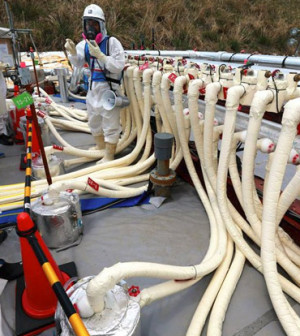Ice wall effort starts to stem toxic leaks
 Japan has begun freezing the earth around the leaking nuclear power facility at Fukushima, hoping to contain radioactive waste with an underground ice wall.
Japan has begun freezing the earth around the leaking nuclear power facility at Fukushima, hoping to contain radioactive waste with an underground ice wall.
Authorities hope the wall will block fresh groundwater flowing down from nearby hillsides, which has been mixing with the toxic water under the plant.
“We started construction of the frozen earth wall this afternoon,” a Tokyo Electric Power (TEPCO) official told a news conference in Tokyo on Monday.
The project will see 1,550 pipes forced down into the soil. A powerful refrigerant will be sent around the pipe network to freeze the ground into a 1.5-kilometre wall to block the inflows.
“We plan to end all the construction work in March 2015 before starting trial operations,” the company official said, saying the ice wall would take several months to be fully operational after construction is completed.
The same ground-freezing technique has been used to protect tunnel workers when digging near watercourses.
It has never been used in a project anywhere near this scale.
The massive flow of water into and out of the area has been a major issue for the authorities dealing with the fallout from the 2011 earthquake, tsunami and nuclear accident.
As well as dealing with millions of litre of radioactive water from the cooling of the plant while it still ran, the groundwater coursing in from surrounding areas continues to add to the problems.
Last month TEPCO started digging a bypass system to divert groundwater into the sea in an attempt to reduce the growing volume of contaminated water.
The decommissioning of the Fukushima plant is expected to take decades.








 Print
Print